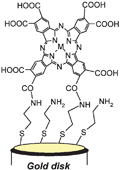Self-assembly and heterogeneous electron transfer properties of metallo-octacarboxyphthalocyanine complexes on gold electrode†
Abstract
Electrochemical properties of redox-active self-assembled molecular films of novel metallo-octacarboxyphthalocyanine (MOCPc, M = Fe, Co and Mn) complexes integrated with


 Please wait while we load your content...
Please wait while we load your content...